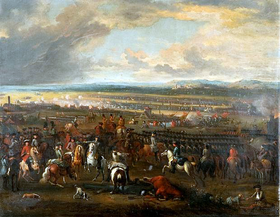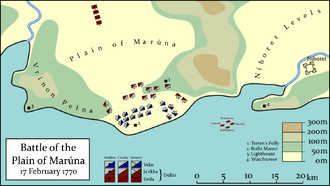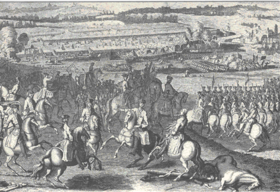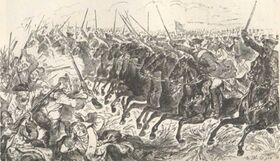Battle of the Plain of Marúna
The Battle of the Plain of Marúna was a major land battle fought over four days, from 16 to 19 February 1770, between Prince Miró of Txir's supporters in Pelna and the armies of Ja'ekha and Trellin. It was the last engagement of the War of the Velaran Succession's Retikan campaign, as the Velaran armies that had twice failed to recapture Zarthalin from Kenti of Ja'ekha were driven back by a combined Ja'ekhan-Trellinese force. Outnumbered and outmanoeuvred, generals Kúfet Heruyel and Atnas Laidakon had withdrawn to the coast of Pelna to await a rendezvous with their transport ships, where they were trapped by armies advancing from east and north.
The drawn-out battle was one of the longest non-siege engagements of the war and was the longest of the Retikan theatre. The Velaran army quickly established strong defensive positions before Kenti's arrival, and he was unable to exploit any weakness in the first two days of skirmishes. Despite receiving reinforcements under the Duke of Emla, an aggressive frontal assault in the afternoon of day two ended in a stalemate and was followed with another, only marginally more successful flanking attack by Kenti on the third day, as the Velaran commanders' counterattack failed to drive away the Ja'ekhan and Emlan army.
Background
It was clear from the outset of the War of the Velaran Succession that Velar's possessions in Pelna and Retikh would be difficult to defend. Though the main strongholds were loyal to Prince Miró, almost a third of the land in the province belonged to nobles who had sided with Elcmar IV. What was left to the Miróists was a somewhat fragmented coastal strip from the Flotir river in the east to the western border with Idisamo. The long northern frontier was exposed to attack by the Trellinese, while the Grand Duchy of Ja'ekha maintained a considerable military presence at Meharz on the Flotir.
Anticipating that the greatest threat would initially come from the east, Velaran general Atnas Laidakon led his army to the Flotir. He crossed the river and assumed a defensive position holding the ford on the main road, but at the Battle of the Fords of Flotir, in early February 1769, he was overwhelmed by Kenti of Ja'ekha's larger army and forced to withdraw. Kenti continued westward with a large train of cannon in his army, meeting little resistance on his way. He was able to take Zarthalin after a short siege and entered the crucial port city on 31 March. Having acquired reinforcements, Laidakon encircled Zarthalin but was repulsed after a two month siege. He spent the next few months attempting to recapture lands that had seceded to Trellin, and met with some success in the north of Pelna. He was subsequently joined by Kúfet Heruyel, who had achieved an important tactical victory at the Sarma. The two generals attempted once more to retake Zarthalin, marching together on the city with about 18,000 men, but after an inconclusive and drawn-out siege they withdrew westward on 2 February in a bid to outmanoeuvre the approaching Trellinese army commanded by the Duke of Emla.
Prelude
As the besieging Velaran armies withdrew from Zarthalin, Kenti received word of the Duke of Emla's approach from the northwest at the head of 9,000 men, having subdued Velaran forces at Tisiyra and across northern Pelna. Knowing Emla would be outnumbered, Kenti left 1,500 of his men under Pahrek Limiykla in Zarthalin with the greater part of his artillery and went in pursuit of the Velaran armies with 12,000 men on 6 February.
As the Trellinese and Ja'ekhan armies pursued the retreating Velarans, a small Trellinese squadron under the command of Admiral Pei Tisarol hung off the coast and shadowed Heruyel's movements, planning to intercept his rendezvous with transport ships. Heruyel and Laidakon had 16,000 men under their command, and if allowed to reach Parthenope it was feared they could turn the tide of the ongoing siege commanded by Modriq, Duke of Lindros.
The Velaran generals made quickly for the coast, knowing there were no friendly fortresses they could reach before they were intercepted: Niboret, on the coast, had defected to Trellin soon after the fall of Zarthalin and its position, across a river on the Niboret Levels, was unassailable; friendly Gahaiyid's fortifications were old and outdated, unlikely to resist modern artillery and far too small to support 16,000 men. The Velarans instead intended to meet their transports at Vrinon Pelna, a cape below the Plain of Marúna where they established their camps. As the scouts reported they were hotly pursued, Heruyel and Laidakon ordered their men to prepare a perimeter of trenches and stakes ringing their large camp. The Velaran generals established their command post in Roihi Manor, which had been abandoned soon after the outbreak of war.
The battle
Day one: deployment and initial forays
The Ja'ekhan army under Grand Duke Kenti drew within sight of the Velaran encampment at about 2 p.m. on the 16th. It was apparent to him and his officers that the Velarans had put their two day head start to good use, as their position was well defended and would clearly repel a direct assault with ease. He therefore took what remained of the afternoon to reconnoiter around the enemy camp and began positioning his own units. The bulk of the artillery under Énohl Meriyiq was deployed on a rise overlooking the plain and shore, with the ruined tower house of Terien's Folly on their left flank. A separate, smaller battery was established on another hill crest to the southwest of the main battery. What little cavalry Kenti had under his command was lined up along the ridge connecting his gun batteries. Skirmishers were sent forward to test the Velaran line as dusk drew in. Although he had hoped to encircle the enemy on all but the seaward side, Kenti was advised that his line would be too thin to prevent them from breaking out, and he left the Velarans' west flank only sparsely guarded, though the regiment he left here under Txoli Qorcan was his best-trained and he expected it to hold its own.
Heruyel and Laidakon watched the Ja'ekhan deployment cautiously, moving their own troops around accordingly. On the flank facing Kenti's cavalry, they reinforced their stake trenches, while sending their own cavalry to harass the forward troops on the west flank. Most of the Ja'ekhan army remained concealed behind the ridge, however, and the Velaran commanders were reluctant to commit to any action until they knew Kenti's numbers. Two hours after sunset, the two camps settled down to a watchful wait.
Day two: Emla arrives
Before dawn, Kenti decided once more to probe the Velaran perimeter and search for weak points. Skirmishes broke out as he sent his cavalry around to the east flank to test their defences, but here too the Velarans were entrenched and the Ja'ekhan horse was repulsed with light casualties. Kenti's scouts reported that the eastern side was thus far the least defensible. Knowing that the Velarans had only to out-wait him and that his forces were insufficient for an open assault, Kenti hoped to convince them his attack would come from the west flank and then launch his actual offensive in the east.
After conferring with his officers, Kenti began his decoy attack at about 6:30 with the western artillery battery opening fire on the Velarans below as the accompanying infantry regiment under Qorcan advanced in formation. The Velaran units formed into their lines, readying to meet the Ja'ekhans as their cavalry repositioned to their left flank. Laidakon was summoned from his command post on the eastern front and arrived on the western at 8 a.m., where he saw "too few men either to attack us or hold their ground, and yet they attempt the both at once. Surely this Kenti cannot be the same as he who routed us at Flotir?" Laidakon determined to repulse the attack, and he organised his units for a counterattack. He advanced up the gentle slope with two regiments, leaving the third with the cavalry to protect his cannon from the Ja'ekhan cavalry. Seeing that their ruse had worked so far, Qorcan drew his regiment up and prepared to engage with the numerically superior Velaran force. At the same time as Qorcan and Laidakon were engaging in the west, Ja'ekhan infantry units in the east and central sectors of the battlefield moved forward to skirmish with the forward Velaran units. Kenti held his cavalry and reserve infantry back, hoping that his opponent would believe these skirmishes to be a decoy for the western flank, but Heruyel refused to compromise his position by retaliating beyond sending out skirmishing detachments.
20 kilometres (12.5 miles) to the north, the army under the Duke of Emla had renewed its march southeast toward Niboret shortly after dawn. On hearing the distant rumble of cannon, he force-marched more directly south, reportedly surprised that Kenti had already engaged the Velarans in combat. Emla encountered Ja'ekhan outriders on the northern plain shortly after 10 a.m. and was apprised of the situation. Qorcan's feint had met with mixed success and was forced to withdraw, but faced with withering fire from the Ja'ekhan cannon Laidakon had chosen not to press home his attack. The skirmishes elsewhere on the field continued, but both sides were leery of overreaching and being left vulnerable. This situation remained little changed by 11 a.m., when the Emlan column encountered the Ja'ekhan rearguard behind the ridge. Kenti joined them soon after to meet with Emla, reassured that he now outnumbered the Velarans and did not need to conceal his reserves any longer.
Emla's column formed into ranks shortly after noon, his infantry deploying between the Ja'ekhan van and rearguard while his cavalry was sent to reinforce Qorcan's position. The Emlan artillery was established behind Kenti's cavalry, which, it was hoped, would serve to screen its advance. After allowing the newly-arrived Emlan army time to rest, the two commanders agreed to take a decisive course of action with a prompt frontal assault on the Velaran lines. Neither expected it to achieve victory, but Kenti had expressed his opinion that Heruyel was too cautious to be goaded out by mere skirmishes. It was therefore their hope that it would force the Velarans to pull resources away from their flanks and contribute to the ongoing misdirection.
The combined Emlan-Ja'ekhan army began its advance soon after 1 p.m. and within half an hour was within range of the Velaran front line. The Velarans were first to open fire, and the line infantry of both sides were soon engaging in vicious fusillades. Simultaneously, the Ja'ekhan skirmishers on the eastern flank pushed forward to harass the Velaran positions while Qorcan's artillery moved downhill to fire on Laidakon's entrenchments. The main body of the combined assault pushed forward, closing the gap between the two lines, but despite their aggressive advance they were unable to break the Velaran line. Instead, the two sides became entangled, and in places units were fighting with bayonets and swords. By 4 p.m., with nearly two thousand dead on each side and little progress made, Kenti ordered his units to withdraw. It took until after sunset for the Ja'ekhan infantry to extricate itself from the battlefield as scattered fighting continued into the evening and the commanders reconsidered their stratagems for the morning.
Day three: the battle continues
The addition of 9,000 Emlan troops posed a serious threat to the Velaran defence: they could no longer count on fending off Kenti's provocations to stall for time. Moreover, the presence of a Trellinese naval squadron off the coast convinced them that they could not simply sit and wait for rescue. The commanders resolved to launch a counter-attack on the third day, hoping either to achieve an outright victory or to at least capture the Ja'ekhan artillery. They laid plans for a major assault, committing at least 5,000 men on the northern and western fronts simultaneously. Their opponents made similar plans, although Kenti still aspired to break the Velaran line on the eastern flank. A major redeployment occurred before dawn, with the Trellinese centre losing troops to its flanks; the Velarans bolstered their centre.
Kúfet and Heruyel's predictions of delayed rescue proved to be correct. A squadron under Commodore Azinto Súkiret was moving eastward along the Pelnan coast with the express purpose of rescuing the army, having escaped a blockade at Parthenope. It encountered Pei Tisarol's squadron near Vrinon Pelna on the afternoon of the 18th and pursued it southward. Having chased Tisarol away, Súkiret was still some distance from Vrinon Pelna when night fell, although he expected to reach shore in the morning.
Day four: escape by sea
Aftermath
Casualties
| Graph of casualties by day |
 |
| (T) Emlan-Ja'ekhan casualties
(V) Velaran casualties
|




